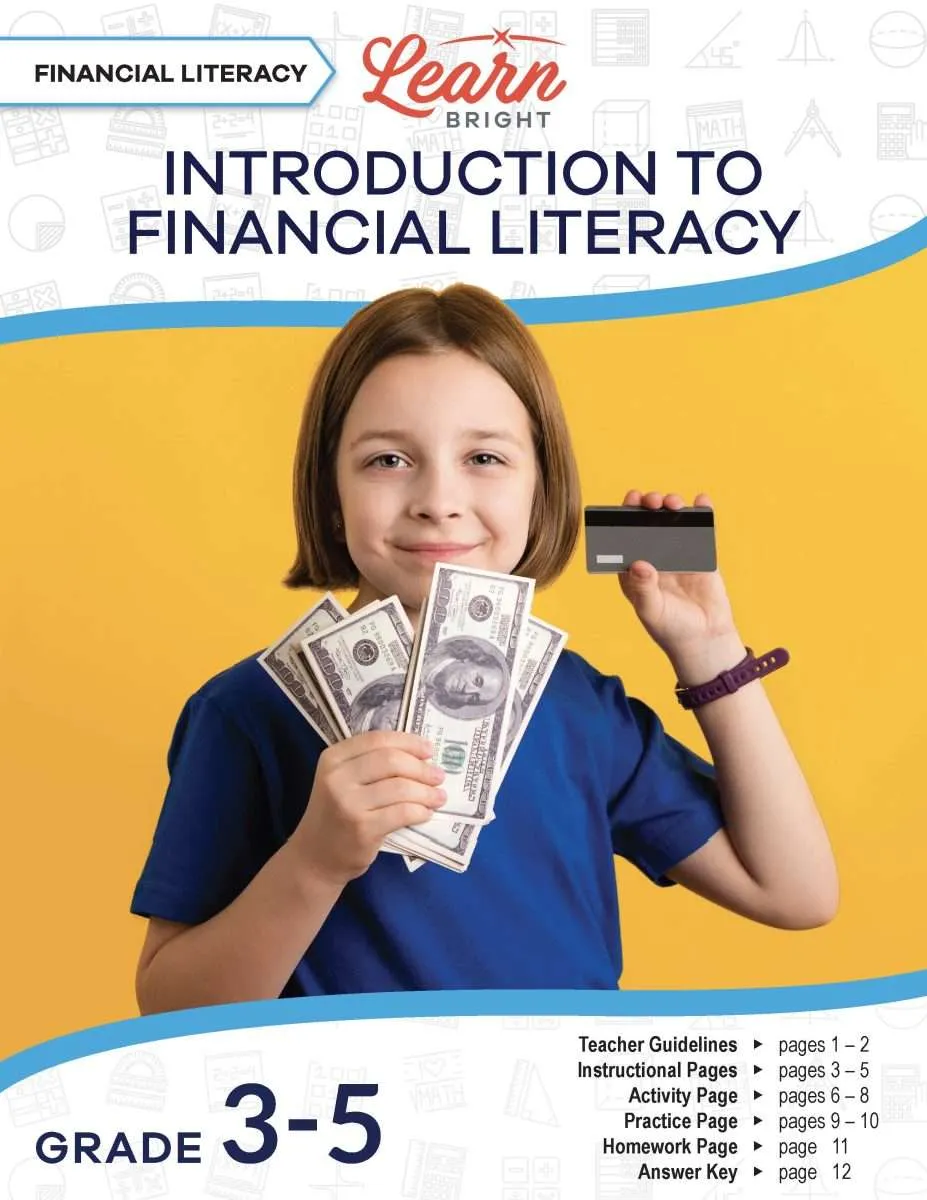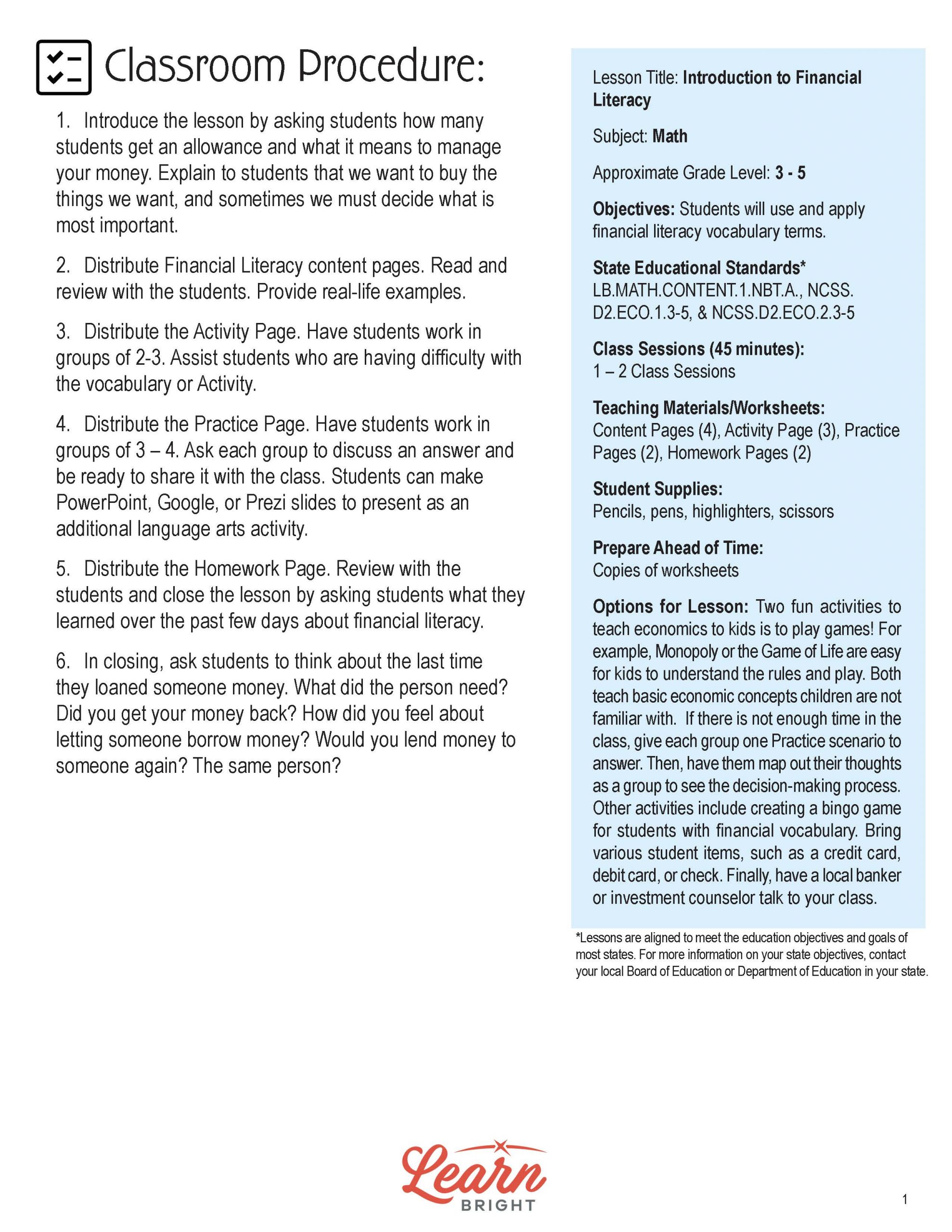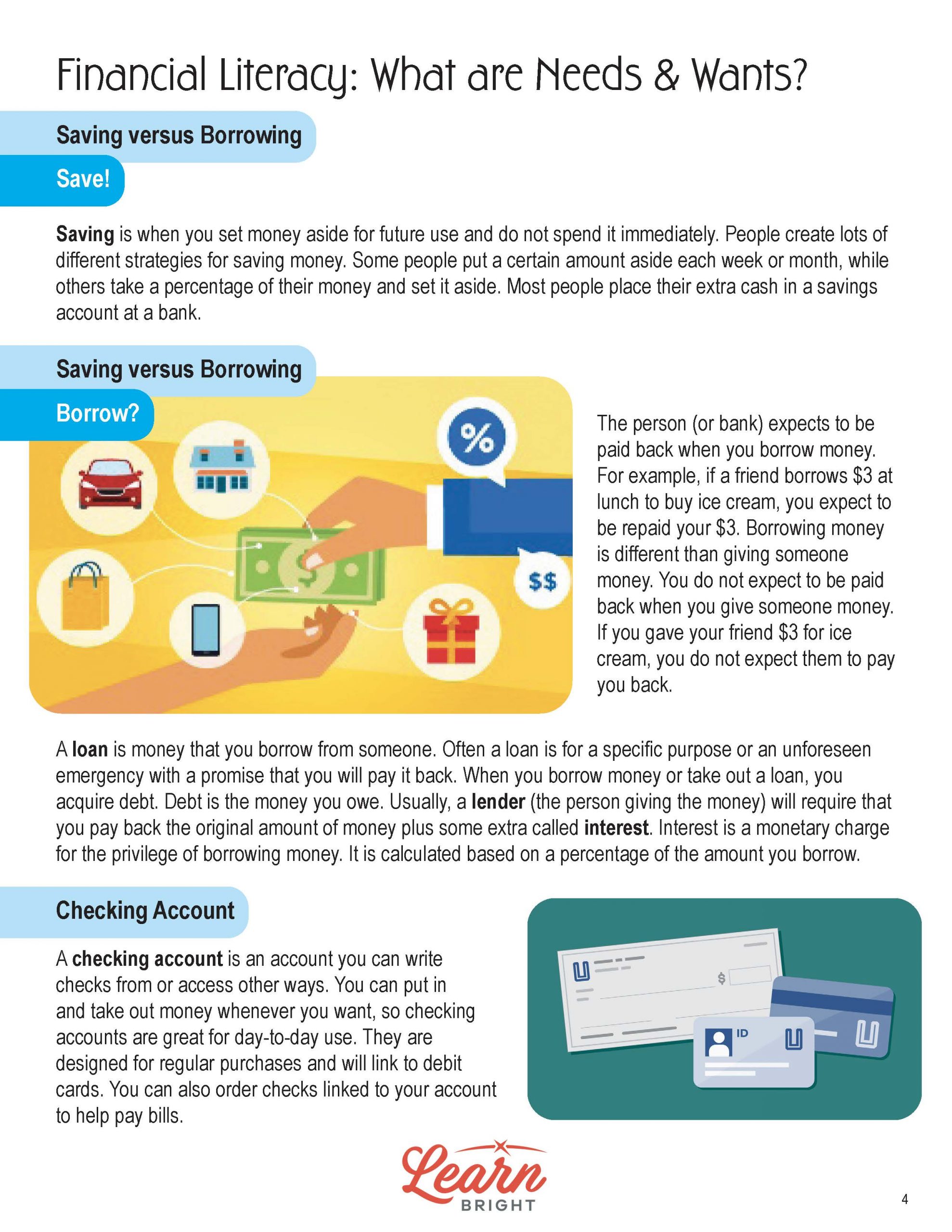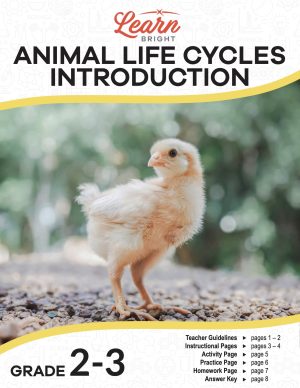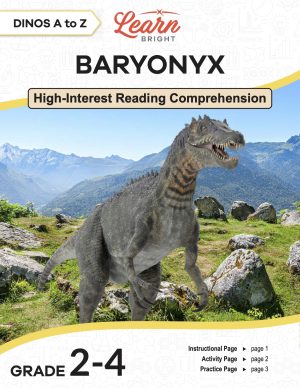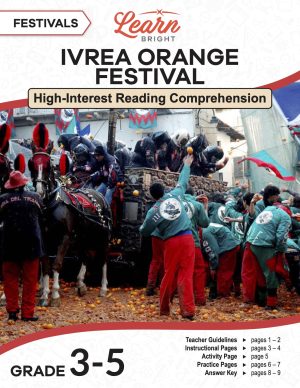Description
What our Introduction to Financial Literacy lesson plan includes
Lesson Objectives and Overview: Introduction to Financial Literacy teaches students the foundation for financial literacy. Students will learn key vocabulary terms and practice using them in a matching game. This lesson is for students in 3rd grade, 4th grade, and 5th grade.
Classroom Procedure
Every lesson plan provides you with a classroom procedure page that outlines a step-by-step guide to follow. You do not have to follow the guide exactly. The guide helps you organize the lesson and details when to hand out worksheets. It also lists information in the blue box that you might find useful. You will find the lesson objectives, state standards, and number of class sessions the lesson should take to complete in this area. In addition, it describes the supplies you will need as well as what and how you need to prepare beforehand. The supplies you will need include pencils, pens, highlighters, and scissors.
Options for Lesson
Included with this lesson is an “Options for Lesson” section that lists a number of suggestions for activities to add to the lesson or substitutions for the ones already in the lesson. One optional addition to the lesson is to play either Monopoly or the Game of Life, as both are easy to understand and teach children basic economic principles. If there is not enough time in the class to complete the entire Practice worksheet, you can give each group one Practice scenario to answer and have them map out their thoughts as a group to see the decision-making process. To add to the lesson, you can create a bingo game for students with financial vocabulary. You could also bring various items talked about in the lesson, such as a credit card, debit card, or check, to show your students. Finally, you can have a local banker or investment counselor talk to your class.
Teacher Notes
The teacher notes page includes a paragraph with additional guidelines and things to think about as you begin to plan your lesson. This page also includes lines that you can use to add your own notes as you’re preparing for this lesson.
INTRODUCTION TO FINANCIAL LITERACY LESSON PLAN CONTENT PAGES
Introduction to Financial Literacy
The Introduction to Financial Literacy lesson plan includes three pages of content. Needs are things you need in order to survive, like food, water, and shelter. Wants are things that you can live without, like skateboards, video games, and stuffed animals. When you create a budget, you need to pay attention to the difference between wants and needs. If you spend your money on things you want, you might not have enough left over for your needs!
Making a Budget
Budgets are plans for managing your money. You can create one using your income (the money you earn), information about cash from gifts, and your expenses (the money you spend). People often make monthly or yearly budgets.
Using a budget helps you create financial stability because they let you track how much you spend and how much you can save. Having this information helps you pay your bills, create an emergency fund (money set aside for an emergency or surprise expense), and save money for large purchases or expenses that you’ll have in the future.
Creating a budget helps you spend within your means, which means that you don’t spend more money than you have. This is the foundation of all budgeting and spending decisions. If you do not spend within your means, you will go into debt, which means you won’t have enough money to pay for the things you need and want. Debt is money that you borrow from someone, like a friend or relative, and need to repay.
Saving versus Borrowing
When you save, you set money aside for future use and don’t spend it right away. Different people have different strategies for saving money. You might put a specific amount of money into savings every week or month, or put a percentage of your earnings away. If you have extra cash, you can put it in a savings account by going to a bank.
When you borrow money, the person or bank that you borrow it from expects you to pay it back. If a friend borrowed $3 from you for ice cream, you want them to pay back that $3. When someone gives you money, on the other hand, they do not expect you to pay it back. This is a very important distinction to make!
Loans are money that you borrow from someone. People often get loans for specific purchases or a surprising emergency and promise that you’ll pay it back later. When you take out a loan, you acquire debt (the money you owe). A lender (the person giving you the money) often requires that you pay back the original amount that you borrowed plus interest. Interest is an added charge for borrowing money, and is calculated as a percentage of the amount of money you owe.
Checking Account
Checking accounts are accounts that you can write checks from or access in other ways. You can put in and take out money easily, so people use them for everyday purchases with a debit card. You can order checks linked to your account to pay bills and make large purchases.
Savings Account
Savings accounts are for long-term money storage. You put that money that you do not need to use immediately into them. People use them to save up for large purchases, emergencies, or to meet short to medium-term financial goals. You do not use them for day-to-day purchases because they only allow a specific number of transactions in a specific time period. Using it too often can cause your bank to charge you a fee.
Savings accounts pay you interest, while checking accounts do not. The bank pays you a fee so they can borrow your money when they need to.
Credit versus Debit
Credit cards are small, hard plastic cards that credit card companies or other financial institutions issue to you. When you use a credit card, you are essentially taking out a small loan because you’re borrowing money from the company. Credit card companies loan you money with the expectation that you will eventually pay it back. They report the charges you make on your credit card to credit bureaus, which is one of the ways you build credit. It’s important to build credit so that you can apply for a car or house loan.
Debit cards, on the other hand, link to your bank account (most likely a checking account instead of a savings account). Banks issue debit cards, which look like credit cards. In this case, however, the back does not loan you money. Using your debit card takes money directly out of your bank account.
Debit or Credit Card
The lesson ends with a comparison of debit and credit cards. Debit cards link to your savings or checking account; credit cards act as loans that you repay each month. Debit cards might charge you a fee for using them at ATMs or stores; with a credit card, you pay interest every month on the amount of the unpaid loan and pay an annual fee. When you use a debit card, the money leaves your account right away; the company who issued your credit card sends reports about how you use your card to a credit bureau, affecting your future access to loans.
Key Terms
Here is a list of the vocabulary words students will learn in this lesson plan:
- Need: Things that you need to survive, like food, clothing, and shelter
- Want: Things that you do not need to survive
- Budget: A plan for managing your money
- Income: Money you earn
- Expenses: Money you spend
- Emergency fund: Money set aside for financial surprises
- Debt: Spending more than you earn
- Lender: Person or bank loaning money
- Interest: Monetary fee paid for borrowing money
- Checking account: Account you can write checks from
- Savings account: Money set aside for future use
- Credit card: Small plastic card issued by a company
- Debit card: Small plastic card issued by your bank that links to your bank account
INTRODUCTION TO FINANCIAL LITERACY LESSON PLAN WORKSHEETS
The Introduction to Financial Literacy lesson plan includes three worksheets: an activity worksheet, a practice worksheet, and a homework assignment. You can refer to the guide on the classroom procedure page to determine when to hand out each worksheet.
DEBIT OR CREDIT GAME ACTIVITY WORKSHEET
Students will work in groups to complete the lesson activity. Each group will cut out the provided cards, mix them up, and spread them out picture side down on a table. Players will take turns flipping two cards over at a tie. If they match two cards, they take both cards. The player with the most cards at the end is the winner!
REAL WORLD APPLICATIONS PRACTICE WORKSHEET
For the practice worksheet, students will work in groups to discuss four real-world scenarios related to money, debt, credit, and other related things. Each group will write down what they would do in each scenario using the knowledge they’ve gained from the lesson.
INTRODUCTION TO FINANCIAL LITERACY HOMEWORK ASSIGNMENT
The homework assignment asks students to match the vocabulary terms with their definitions.
Worksheet Answer Keys
This lesson plan includes answer keys for the practice worksheet and the homework assignment. If you choose to administer the lesson pages to your students via PDF, you will need to save a new file that omits these pages. Otherwise, you can simply print out the applicable pages and keep these as reference for yourself when grading assignments.

